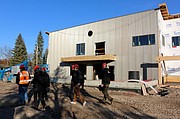Work progressing on sustainability center
Hilary Matheson Daily Inter Lake | Hagadone News Network | UPDATED 8 years, 1 month AGO
The Center for Sustainability and Entrepreneurship at Whitefish High School is starting to take shape.
Work will begin soon on the greenhouse, the main feature of the center.
“It’s going to look a lot different in a month,” Larry Palmer, project manager and superintendent at Martel Construction, said during a site tour on Friday following Whitefish Community Foundation’s presentation of a $25,000 grant for the project.
When completed, the two-story center will feature classrooms, gardens, an experimental forest, native grass meadow, orchard and wet meadow detention pond.
From the outside, the center looks like a normal building. What isn’t obvious are the details in how it’s being constructed to be a “net-zero energy building,” according to Ryder Delaloye, director of curriculum and instruction. A zero-energy building means the amount of energy used will equal the renewable energy created on-site.
The roughly 3,000-square-foot building will use a combination of renewable energy systems. About 8 feet under the ground in one area is a geothermal system. Solar arrays will be installed on the roofing. Rainwater will be captured to irrigate the greenhouse. Underneath the greenhouse are climate batteries — coiled piping that will circulate greenhouse air to control temperature.
Delaloye pointed out other details such as triple-paned windows and low ceilings that will help conserve energy.
“Thinking about every element of this to get to net-zero energy was a key process,” Delaloye said. “The story we want to tell is anyone can create a much more efficient, much more sustainable facility with integrated design principles and smart planning.”
The center will be the site of hands-on curriculum in the areas of agriculture, energy, forestry, natural resources, entrepreneurship and sustainable practices. The goal is to have kindergartners through 12th-graders using the center.
Using forestry as an example, Delaloye said students can better understand the history of Whitefish as a timber town, career paths and “the ecology that surrounds us,” through the management and scientific study of the future experimental forest.
Moving on to the future site of the production garden, Delaloye said it will serve as a laboratory.
“So, we’re not looking to produce all the food for the district, rather learn how to explore different things, different topics or concepts related to horticulture, permaculture and growing strategies,” he said.
The center also may serve as the location for adult education workshops or lectures.
“Imagine a conference on permaculture, or a weekend workshop on how to put a solar array on your home,” Delaloye said.
The center began as a grassroots effort in 2014 by the high school Freeflow Club members, adviser Eric Sawtelle and English teacher Nikki Reed, who all wanted to replace the school’s aging greenhouse after it was demolished during the school’s reconstruction.
By 2015, $70,000 was raised through the support of community philanthropist Richard Atkinson. The project snowballed into what it is today after $2.1 million in private donations rolled in and designs for the center were presented to the community in January 2017.
Construction and start-up costs in the coming years such as staffing, are estimated at $2.65 million and will be funded by donations and grants like the one given by the Whitefish Community Foundation, which maintains a designated fund for the center.
“Thanks for leaving this legacy for Whitefish schools and the Whitefish community,” Whitefish Superintendent Heather Davis Schmidt said after thanking the foundation, Whitefish philanthropists and the vision of students and staff.
Sustainability is a district-wide focus, from the classroom to building maintenance and food services. In May the school district made the cut as a Green Ribbon School through the U.S. Department of Education. Green Ribbon schools strive to “reduce environmental impact and costs; improve the health and wellness of schools, students, and staff; and provide environmental education, which teaches many disciplines, and is especially good at effectively incorporating STEM, civic skills and green-career pathways,” according to the U.S. Department of Education.
The goal is to open the Center for Sustainability in April 2018.
Reporter Hilary Matheson may be reached at 758-4431 or [email protected].
ARTICLES BY HILARY MATHESON DAILY INTER LAKE
No headline
The University of Montana is still in the early stages of transformation under the leadership of university president Seth Bodnar.
No headline
A lifelong learner
After 11 years at Edgerton Elementary, Merisa Murray will open new doors in her career as principal of Rankin Elementary when it opens in 2018.



